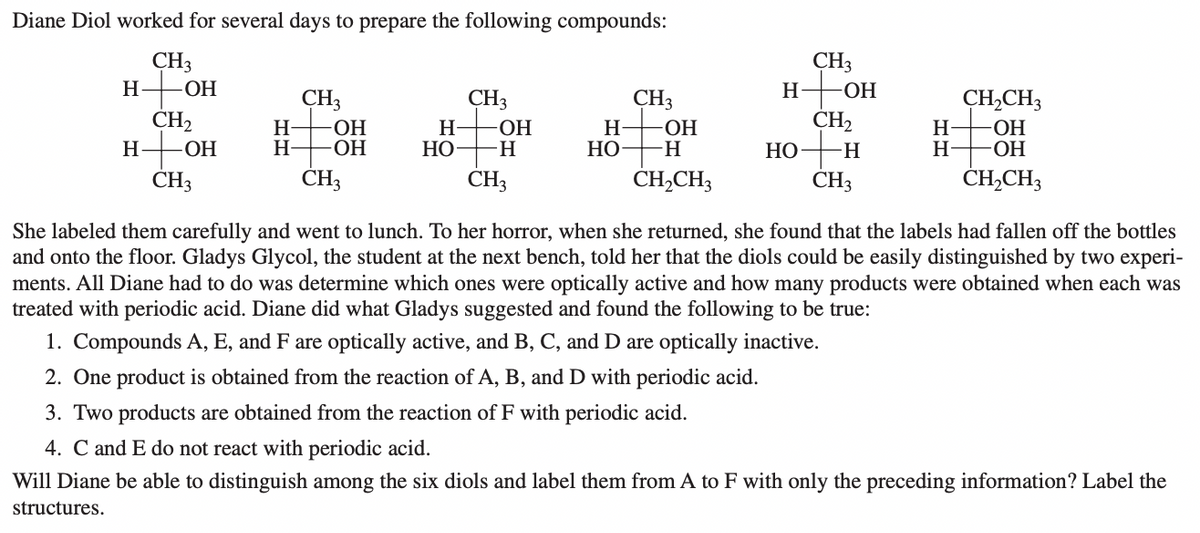Diane Diol worked for several days to prepare the following compounds: CH3 Н— он CH2 H-OH ČH3 CH3 н— он CH2 HO-H CH,CH3 CH3 OH -ОН CH3 H НО CH3 H- H- ОН -H- H- HO -OH- -H H- H- -ОН -ОН CH3 ČHĄCH3 CH3 ČHĄCH3 She labeled them carefully and went to lunch. To her horror, when she returned, she found that the labels had fallen off the bottles and onto the floor. Gladys Glycol, the student at the next bench, told her that the diols could be easily distinguished by two experi- ments. All Diane had to do was determine which ones were optically active and how many products were obtained when each was treated with periodic acid. Diane did what Gladys suggested and found the following to be true: 1. Compounds A, E, and F are optically active, and B, C, and D are optically inactive. 2. One product is obtained from the reaction of A, B, and D with periodic acid. 3. Two products are obtained from the reaction of F with periodic acid. 4. C and E do not react with periodic acid. Will Diane be able to distinguish among the six diols and label them from A to F with only the preceding information? Label the structures.
Diane Diol worked for several days to prepare the following compounds: CH3 Н— он CH2 H-OH ČH3 CH3 н— он CH2 HO-H CH,CH3 CH3 OH -ОН CH3 H НО CH3 H- H- ОН -H- H- HO -OH- -H H- H- -ОН -ОН CH3 ČHĄCH3 CH3 ČHĄCH3 She labeled them carefully and went to lunch. To her horror, when she returned, she found that the labels had fallen off the bottles and onto the floor. Gladys Glycol, the student at the next bench, told her that the diols could be easily distinguished by two experi- ments. All Diane had to do was determine which ones were optically active and how many products were obtained when each was treated with periodic acid. Diane did what Gladys suggested and found the following to be true: 1. Compounds A, E, and F are optically active, and B, C, and D are optically inactive. 2. One product is obtained from the reaction of A, B, and D with periodic acid. 3. Two products are obtained from the reaction of F with periodic acid. 4. C and E do not react with periodic acid. Will Diane be able to distinguish among the six diols and label them from A to F with only the preceding information? Label the structures.
Introduction to General, Organic and Biochemistry
11th Edition
ISBN:9781285869759
Author:Frederick A. Bettelheim, William H. Brown, Mary K. Campbell, Shawn O. Farrell, Omar Torres
Publisher:Frederick A. Bettelheim, William H. Brown, Mary K. Campbell, Shawn O. Farrell, Omar Torres
Chapter15: Chirality: The Handedness Of Molecules
Section: Chapter Questions
Problem 15.41P: 15-41 Compound A(C5Hh, is not optically active and cannot be separated into enantiomers. It reacts...
Related questions
Question

Transcribed Image Text:Diane Diol worked for several days to prepare the following compounds:
CH3
H-OH
CH2
H-OH
ČH3
CH3
H-OH
CH2
CH3
CH3
CH3
ОН
CH,CH3
H-
H-
HO-
ОН
H-
НО
-HO-
-H-
H-
НО
H-
H-
-ОН
ОН
НО
H.
CH3
CH3
CH,CH3
CH3
ČH,CH3
She labeled them carefully and went to lunch. To her horror, when she returned, she found that the labels had fallen off the bottles
and onto the floor. Gladys Glycol, the student at the next bench, told her that the diols could be easily distinguished by two experi-
ments. All Diane had to do was determine which ones were optically active and how many products were obtained when each was
treated with periodic acid. Diane did what Gladys suggested and found the following to be true:
1. Compounds A, E, and F are optically active, and B, C, and D are optically inactive.
2. One product is obtained from the reaction of A, B, and D with periodic acid.
3. Two products are obtained from the reaction of F with periodic acid.
4. C and E do not react with periodic acid.
Will Diane be able to distinguish among the six diols and label them from A to F with only the preceding information? Label the
structures.
Expert Solution
This question has been solved!
Explore an expertly crafted, step-by-step solution for a thorough understanding of key concepts.
This is a popular solution!
Trending now
This is a popular solution!
Step by step
Solved in 2 steps with 10 images

Recommended textbooks for you

Introduction to General, Organic and Biochemistry
Chemistry
ISBN:
9781285869759
Author:
Frederick A. Bettelheim, William H. Brown, Mary K. Campbell, Shawn O. Farrell, Omar Torres
Publisher:
Cengage Learning


Introduction to General, Organic and Biochemistry
Chemistry
ISBN:
9781285869759
Author:
Frederick A. Bettelheim, William H. Brown, Mary K. Campbell, Shawn O. Farrell, Omar Torres
Publisher:
Cengage Learning
